Related Research Articles

The beet armyworm or small mottled willow moth is one of the best-known agricultural pest insects. It is also known as the asparagus fern caterpillar. It is native to Asia, but has been introduced worldwide and is now found almost anywhere its many host crops are grown. The voracious larvae are the main culprits. In the British Isles, where it is an introduced species and not known to breed, the adult moth is known as the small mottled willow moth.

Enyo lugubris, the mournful sphinx, is a moth of the family Sphingidae. It is found from Argentina and Paraguay to Uruguay, Venezuela, Guyana, Suriname, French Guiana, Colombia, Ecuador, Peru, Brazil and the West Indies through Belize, Guatemala, Honduras, El Salvador, Nicaragua, Costa Rica and Panama to Mexico and the United States, where it has been recorded from Arizona east to Florida and north to South Carolina. Strays have been recorded from Arkansas, north to Illinois, Michigan and New York.

Eutrapela is a genus of moths in the family Geometridae. It contains only one species, Eutrapela clemataria, the curve-toothed geometer moth or purplish-brown looper, which is found in North America, where it has been recorded from Nova Scotia to Florida, west to Texas and north to Saskatchewan. The habitat consists of deciduous and mixed woodlands.
Exelastis montischristi is a species of moth in the genus Exelastis known from Hispaniola, Ecuador, Grenada, Jamaica, Martinique, the Virgin Islands, Florida and Texas. It has also been recorded from Tanzania.
Cosmopterix pulchrimella, the beautiful cosmopterix moth, is a moth of the family Cosmopterigidae. It is known from the United States and Canada. It is also present in the Palearctic realm, where it is known from the Mediterranean Basin, from Portugal to the western Transcaucasus, north to Switzerland and Hungary. It has also been recorded from the Azores, the Canary Islands and Madeira. It has recently been found in southern England.

Syngamia florella, the orange-spotted flower moth or red waisted florella moth, is a moth of the family Crambidae. It was described by Caspar Stoll in 1781. It is found from South Carolina to Florida and from Arkansas to Texas, south to the West Indies and through Mexico to Argentina. It is also found on Bermuda.

Elophila gyralis, the waterlily borer moth, is a moth in the family Crambidae. It was described by George Duryea Hulst in 1886. It is found in eastern North America, where it has been recorded from Alabama, Florida, Georgia, Illinois, Indiana, Iowa, Louisiana, Maine, Maryland, Massachusetts, Michigan, Minnesota, Mississippi, New Brunswick, New Hampshire, New Jersey, New York, North Carolina, Nova Scotia, Ohio, Oklahoma, Ontario, Pennsylvania, Quebec, South Carolina, Tennessee, Texas and Wisconsin.
Neodactria caliginosellus, the corn root webworm or black grass-veneer, is a moth in the family Crambidae. It was described by James Brackenridge Clemens in 1860. It is found in North America, where it has been recorded from Alabama, Alberta, California, Florida, Georgia, Illinois, Indiana, Maine, Maryland, Mississippi, North Carolina, Ohio, Oklahoma, Ontario, South Carolina and Tennessee. The habitat consists of grassy areas and fields.
Rhectocraspeda periusalis, the eggplant webworm moth, is a moth in the family Crambidae. It was described by Francis Walker in 1859. It is found in the West Indies and from the United States, where it has been recorded from Florida, North Carolina, Ohio, Oklahoma, South Carolina and Tennessee, south through Mexico and Central America to South America, including Ecuador, Brazil, Guyana, Trinidad and Tobago and Suriname.

Arugisa lutea, the common arugisa moth, is a species of moth in the family Erebidae. The species was first described by John B. Smith in 1900. It is found in the United States, where it has been recorded from Maryland and Virginia to Florida, west to Texas and Missouri.
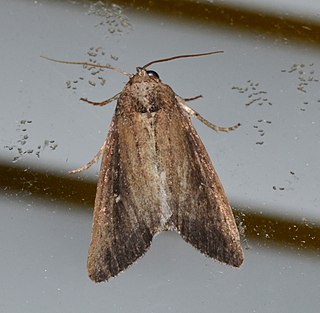
Condica videns, the white-dotted groundling moth, is a moth of the family Noctuidae. It is found in North America, where it has been recorded from Texas to Florida, north to Quebec and west to Alberta.

Eucosma dorsisignatana, the triangle-backed eucosma, is a species of moth of the family Tortricidae. It is found in North America, where it has been recorded from Nova Scotia to Florida, west to Texas and north to Manitoba.
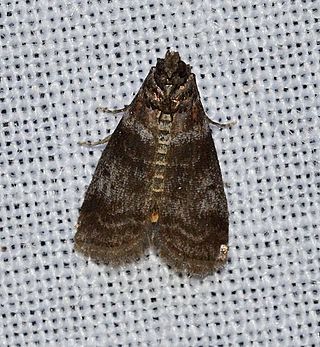
Sciota uvinella, the sweetgum leafroller moth, is a species of snout moth in the genus Sciota. It was described by Ragonot in 1887. It is found in North America, where it has been recorded from New Jersey to Florida, west to Texas and Kentucky.
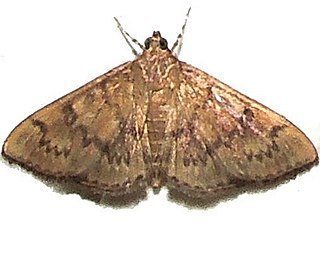
Psara obscuralis, the obscure psara moth, is a moth of the family Crambidae. It is found in North America, where it has been recorded from Maryland to Florida, west to Texas and Illinois. In the south, the range extends to Central America, where it has been recorded from Mexico and Costa Rica.
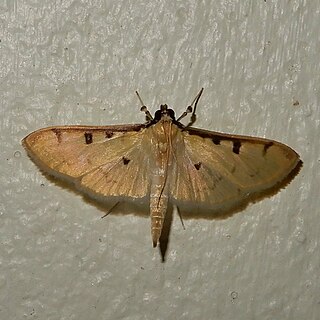
Lygropia tripunctata, the sweetpotato leafroller, is a species of moth in the family Crambidae. It was described by Johan Christian Fabricius in 1794. It is found in the United States, where it has been recorded from Texas to South Carolina and Florida. It is also found from the West Indies and Central America to Brazil.

Lobocleta peralbata is a moth in the family Geometridae. It is found in North America, where it has been recorded from Arizona to Florida, north to North Carolina.
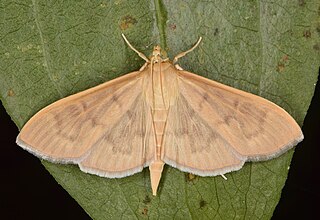
Patania silicalis, commonly known as the herbivorous pleuroptya moth, is a species of moth in the subfamily Spilomelinae of the family Crambidae. It was described by Achille Guenée in 1854. It is found in Brazil, Venezuela, Ecuador, French Guiana, Guyana, Guatemala, Costa Rica, Panama, Mexico, Cuba, Jamaica, Puerto Rico, Hispaniola and the United States, where it has been recorded from Missouri, Michigan, Ohio and New York, south to Florida.
Penestola bufalis, the black penestola moth, is a moth in the family Crambidae. It was described by Achille Guenée in 1854. It is found in the US states of Texas and Florida, as well as on the Antilles. It is an accidentally introduced species on the Galápagos Islands. The habitat consists of coastal mangrove swamps and shorelines.
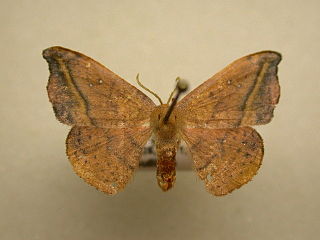
Oreta rosea, the rose hooktip moth, is a moth in the family Drepanidae. It was described by Francis Walker in 1855. It is found in North America, where it has been recorded across boreal Canada to eastern North America. In the north, the range extends to northern Alberta, northern Manitoba and Newfoundland. It is also found east of the Great Plains as far south as Florida and eastern Texas. The habitat consists of moist temperate hardwood forests.
Dichomeris setosella is a moth in the family Gelechiidae. It was described by James Brackenridge Clemens in 1860. It is found in North America, where it has been recorded from New York to Florida, Manitoba, eastern Kansas, Oklahoma, Texas and Kentucky.
References
- ↑ "GlobIZ search". Global Information System on Pyraloidea. Retrieved 2014-07-15.
- ↑ BOLD Systems
- ↑ mothphotographersgroup
- ↑ List Spec. Lepid. Insects Colln Br. Mus. 19: 959
 This article incorporates text from this source, which is in the public domain .
This article incorporates text from this source, which is in the public domain .